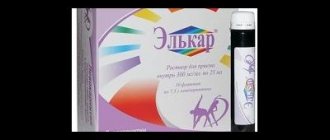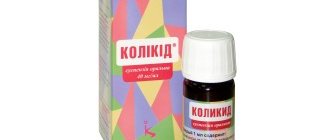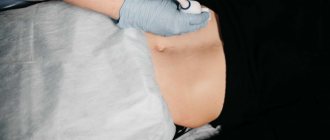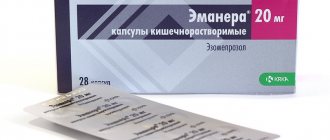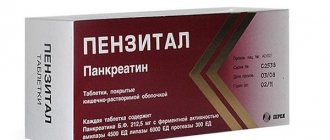Exhol® (Exhol®)
Children and adults weighing less than 47 kg are recommended to use ursodeoxycholic acid in the form of a suspension.
Dissolution of cholesterol gallstones
The recommended dose is 10 mg of ursodeoxycholic acid per 1 kg of body weight per day, which corresponds to:
| Body mass | Capsules |
| Up to 60 kg | 2 |
| 61-80 kg | 3 |
| 81-100 kg | 4 |
| Over 100 kg | 5 |
The drug must be taken daily in the evening, before bed (the capsules are not chewed), with a small amount of liquid.
Duration of treatment is 6-12 months. To prevent recurrent cholelithiasis, it is recommended to take the drug for several months after the stones have dissolved.
Treatment of biliary reflux gastritis
1 capsule of Exchol® daily in the evening before bed, without chewing and with a small amount of water.
The course of treatment is from 10-14 days to 6 months, if necessary - up to 2 years.
Treatment of primary biliary cirrhosis
The daily dose depends on body weight and ranges from 3 to 7 capsules (approximately 14 ± 2 mg ursodeoxycholic acid per 1 kg of body weight).
In the first 3 months of treatment, taking Exchol® capsules 250 mg should be divided into several doses throughout the day. After improvement of liver parameters, the daily dose of the drug can be taken once in the evening.
The following mode of application is recommended:
250 mg capsules
| Body weight (kg) | Exchol® capsules 250 mg | |||
| first 3 months of treatment | Subsequently | |||
| morning | day | evening | evening (1 per day) | |
| 47-62 | 1 | 1 | 1 | 3 |
| 63-78 | 1 | 1 | 2 | 4 |
| 79-93 | 1 | 2 | 2 | 5 |
| 94-109 | 2 | 2 | 2 | 6 |
| over 110 | 2 | 2 | 3 | 7 |
Capsules should be taken regularly, without chewing, with a small amount of liquid.
The use of ursodeoxycholic acid for the treatment of primary biliary cirrhosis can be continued indefinitely.
In patients with primary biliary cirrhosis, in rare cases, clinical symptoms may worsen at the beginning of treatment, for example, itching may become more frequent. In this case, treatment should be continued, taking one capsule daily, then the dosage should be gradually increased, increasing the daily dose by one capsule weekly, until the recommended dosage regimen is achieved again.
Symptomatic treatment of chronic hepatitis of various origins is a daily dose of 10-15 mg/kg in 2-3 doses. Duration of treatment is 6-12 months or more.
Primary sclerosing cholangitis - daily dose 12-15 mg/kg; if necessary, the dose can be increased to 20-30 mg/kg in 2-3 doses. The duration of therapy ranges from 6 months to several years (see section: “Special instructions”).
Cystic fibrosis (cystic fibrosis) - daily dose of 20 mg/kg/day in 2-3 doses, with a further increase to 30 mg/kg/day if necessary.
| Body weight (kg) | Daily dose (mg/kg body weight) | Exchol® capsules 250 mg | ||
| morning | day | evening | ||
| 20-29 | 17-25 | 1 | — | 1 |
| 30-39 | 19-25 | 1 | 1 | 1 |
| 40-49 | 20-25 | 1 | 1 | 2 |
| 50-59 | 21-25 | 1 | 2 | 2 |
| 60-69 | 22-25 | 2 | 2 | 2 |
| 70-79 | 22-25 | 2 | 2 | 3 |
| 80-89 | 22-25 | 2 | 3 | 3 |
| 90-99 | 23-25 | 3 | 3 | 3 |
| 100-109 | 23-25 | 3 | 3 | 4 |
| >110 | 3 | 4 | 4 | |
Non-alcoholic steatohepatitis - average daily dose of 10-15 mg/kg in 2-3 doses. The duration of therapy ranges from 6-12 months or more.
Alcoholic liver disease - average daily dose of 10-15 mg/kg in 2-3 doses. The duration of therapy ranges from 6-12 months or more.
Biliary dyskinesia - average daily dose of 10 mg/kg in 2 divided doses for 2 weeks to 2 months. If necessary, it is recommended to repeat the course of treatment.
Exchol tablets ppo 500 mg No. 50
Compound
Active substance: ursodeoxycholic acid 500 mg.
Excipients: calcium hydrogen phosphate dihydrate 40 mg, calcium stearate 7 mg, sodium carboxymethyl starch 28.00 mg, potato starch 33.5 mg, mannitol 58 mg, macrogol 4000 (polyethylene glycol 4000) 3.5 mg, povidone K-30 30 mg;
Film shell composition: Onadry white 20 mg, including: hypromellose (hydroxypropyl methylcellulose) 6.75 mg, hyprolose (hydroxypronylcellulose) 6.75 mg, talc 4 mg, titanium dioxide 2.5 mg.
Pharmacokinetics
After oral administration, ursodeoxycholic acid is rapidly absorbed in the jejunum and proximal ileum by passive diffusion, and in the distal ileum by active transport.
Approximately 60-80% is absorbed. After absorption, ursodeoxycholic acid is almost completely conjugated in the liver with glycine and taurine and excreted in the bile. During the first passage through the liver, up to 60% is metabolized. Depending on the daily dose, type of disease or condition of the liver, more or less amount of ursodeoxycholic acid accumulates in the bile. At the same time, there is a relative decrease in the content of other more lipophilic bile acids.
Under the influence of intestinal bacteria, ursodeoxycholic acid is partially degraded to form 7-keto-lithocholic and lithocholic acids. Lithocholic acid is hepatotoxic and causes damage to the liver parenchyma in some animal species. In humans, it is absorbed only in small quantities, sulfated in the liver and thus detoxified before excretion into bile and excretion in feces. The half-life of ursodeoxycholic acid is 3.5-5.8 days.
Indications for use
- Dissolution of small and medium-sized cholesterol stones with a functioning gallbladder;
- biliary reflux gastritis;
- primary biliary cirrhosis of the liver in the absence of signs of decompensation (symptomatic treatment);
- chronic hepatitis of various origins;
- primary sclerosing cholangitis;
- cystic fibrosis (cystic fibrosis);
- non-alcoholic steatohepatitis;
- alcoholic liver disease;
- biliary dyskinesia.
Contraindications
- X-ray positive (high calcium) gallstones;
- violation of the contractility of the gallbladder and bile ducts;
- occlusion of the biliary tract;
- frequent episodes of biliary colic;
- hypersensitivity to the components of the drug or other bile acids;
- children under 3 years of age (for solid dosage forms);
- liver cirrhosis in the stage of decompensation and severe liver and/or kidney failure.
Pediatric population
Unsuccessfully performed portoenterostomy or cases of failure to restore normal bile outflow in children with biliary atresia.
For children under 3 years of age, as well as patients with difficulty swallowing solid dosage forms, it is recommended to use ursodeoxycholic acid preparations in the form of a suspension.
Directions for use and doses
For patients who cannot swallow Exchol® film-coated tablets, 500 mg, or whose body weight is less than 47 kg, it is recommended to use ursodeoxycholic acid in capsules or suspension. The tablets should be taken without chewing, with liquid. They should be taken regularly.
Dissolution of cholesterol gallstones
The recommended dose is 10 mg of ursodeoxycholic acid per 1 kg of body weight per day, which corresponds to:
- up to 60 kg 1 tablet
- 61 - 80 kg 1 1/2 tablets
- 81-100 kg 2 tablets
- over 100 kg 2 1/2 tablets
It usually takes 6-24 months for gallstones to dissolve. If after 12 months of treatment the size of the stones does not decrease, then treatment should be stopped.
The effectiveness of treatment should be assessed every 6 months with ultrasound or radiography. During the interim examination, it is necessary to assess whether calcification of the stones has occurred during the intervening period. In case of calcification of stones, treatment should be discontinued.
Treatment of biliary reflux gastritis
250 mg (1/2 tablet) daily in the evening before bed.
The course of treatment is from 10-14 days to 6 months, if necessary - up to 2 years.
Treatment of primary biliary cirrhosis
The daily dose depends on body weight and varies from 1-1/2 to 3-1/2 tablets (14 ± 2 mg ursodeoxycholic acid per 1 kg of body weight). After improving the functional parameters of the liver, you can switch to a single daily dose in the evening
| Body weight (kg) | Daily dose (mg/kg) | Exchol® film-coated tablets, 500 mg | |||
| first 3 months | Subsequently | ||||
| morning | noon | evening | evening (single dose) | ||
| 47-62 | 112-16 | 1/2 | 1/2 | 1/2 | 1 1/2 |
| 63-78 | 13-16 | 1/2 | 1/2 | 1 | 2 |
| 79-93 | 13-16 | 1/2 | 1 | 1 | 2 1/2 |
| 94-109 | 14-16 | 1 | 1 | 1 | 3 |
| more than 110 | — | 1 | 1 | 1 1/2 | 3 1/2 |
The use of ursodeoxycholic acid for the treatment of primary biliary cirrhosis can be continued indefinitely. In patients with primary biliary cirrhosis, in rare cases, clinical symptoms may worsen at the beginning of treatment, for example, itching may become more frequent. In this case, treatment should be continued, taking 1/2 tablet daily, then the dose should be gradually increased (increasing the daily dose weekly by 1/2 tablet) until the recommended dosage regimen is achieved again.
Symptomatic treatment of chronic hepatitis of various origins is a daily dose of 10-15 mg/kg in 2-3 doses. Duration of treatment is 6-12 months or more.
Primary sclerosing cholangitis - daily dose 12-15 mg/kg; if necessary, the dose can be increased to 20 mg/kg in 2-3 doses. The duration of therapy ranges from 6 months to several years (see section: “Special instructions”).
Cystic fibrosis (as part of complex therapy) - daily dose of 20 mg/kg/day in 2-3 divided doses, with a further increase to 30 mg/kg/day if necessary.
| Body weight (kg) | Daily dose (mg/kg body weight) | Exchol® film-coated tablets, 500 mg | ||
| morning | noon | evening | ||
| 20-29 | 17-25 | 1/2 | — | 1/2 |
| 30-39 | 19-25 | 1/2 | 1/2 | m |
| 40-49 | 20-25 | 1/2 | 1/2 | 1 |
| 50-59 | 21-25 | 1/2 | 1 | 1 |
| 60-69 | 22-25 | 1 | 1 | 1 |
| 70-79 | 22-25 | 1 | 1 | 1 1/2 |
| 80-89 | 22-25 | 1 | 1 1/2 | 1 1/2 |
| 90-99 | 23-25 | 1 1/2 | 1 1/2 | 1 1/2 |
| 100-109 | 23-25 | 1 1/2 | 1 1/2 | 2 |
| >110 | 1 1/2 | 2 | 2 | |
Non-alcoholic steatohepatitis - average daily dose of 10-15 mg/kg in 2-3 doses. The duration of therapy ranges from 6-12 months or more.
Alcoholic liver disease - average daily dose of 10-15 mg/kg in 2-3 doses. The duration of therapy ranges from 6-12 months or more.
Biliary dyskinesia - average daily dose of 10 mg/kg in 2 divided doses for 2 weeks to 2 months. If necessary, it is recommended to repeat the course of treatment.
Storage conditions
At a temperature not exceeding 25°C in the manufacturer's packaging. Keep out of the reach of children.
Best before date
2 years. Do not use after the expiration date.
special instructions
Ursodeoxycholic acid should be taken under medical supervision. During the first 3 months of treatment, liver function parameters (transaminases, alkaline phosphatase and gamma-glutamyl transpeptidase) in the blood serum should be monitored every 4 weeks and then every 3 months. Monitoring these parameters makes it possible to identify liver dysfunction in the early stages. This also applies to patients in the later stages of primary biliary cirrhosis. In addition, it can quickly determine whether a patient with primary biliary cirrhosis is responding to treatment.
When used in patients to dissolve cholesterol gallstones:
In order to assess progress in treatment and to promptly identify signs of calcification of stones depending on the size of the stones, the gallbladder should be visualized (oral cholecystography) with examination of dark spots in the standing and supine position (ultrasound examination) after 6-10 months after the start of treatment.
If the gallbladder cannot be visualized on x-rays or in cases of calcification of stones, poor contractility of the gallbladder or frequent attacks of colic, Exchol® should not be used.
When treating patients in the late stages of primary biliary cirrhosis: Cases of decompensation of liver cirrhosis have been reported extremely rarely. After cessation of therapy, regression of decompensation manifestations was noted.
In patients with primary biliary cirrhosis, in rare cases, at the beginning of treatment, clinical symptoms may increase, for example, itching may increase. In this case, the dose of the drug must be reduced to 250 mg (1/2 tablet), and then gradually increased again, as described in the “Method of administration and dosage” section.
When used in patients with primary sclerosing cholangitis:
Long-term therapy with high doses of ursodeoxycholic acid (28-30 mg/kg/day) in patients with this pathology can cause serious side effects.
In patients with diarrhea, the dosage of the drug should be reduced. If diarrhea persists, treatment should be discontinued.
Women of childbearing age can take the drug only if they are using reliable contraception. It is recommended to use non-hormonal contraceptives or oral contraceptives with low estrogen content, since hormonal oral contraceptives may increase gallstone formation. Before starting treatment, possible pregnancy should be excluded.
Description
Hepatoprotective agent.
Pharmacodynamics
Hepatoprotective agent, has a choleretic effect. Reduces cholesterol synthesis in the liver, its absorption in the intestines and concentration in bile, increases the solubility of cholesterol in the biliary system, stimulates the formation and secretion of bile. Reduces the lithogenicity of bile, increases the content of bile acids; causes increased gastric and pancreatic secretion, enhances lipase activity, and has a hypoglycemic effect. Causes partial or complete dissolution of cholesterol stones when administered enterally, reduces the saturation of bile with cholesterol, which promotes the mobilization of cholesterol from gallstones. It has an immunomodulatory effect, affects immunological reactions in the liver: it reduces the expression of certain antigens on the hepatocyte membrane, affects the number of T-lymphocytes, the formation of interleukin-2, and reduces the number of eosinophils.
Pediatric population
Cystic fibrosis (cystic fibrosis)
According to clinical reports, there is many years of experience (up to 10 years or more) in treating pediatric patients with cystic fibrosis-associated hepatobiliary disease (CFAHD) with ursodeoxycholic acid. There is evidence that ursodeoxycholic acid therapy can reduce bile duct proliferation, slow the development of lesions detected by histological examination, and even promote the reversal of changes in the hepatobiliary system if therapy is started in the early stages of CFAHD. To optimize treatment efficacy, ursodeoxycholic acid therapy should be initiated as soon as possible after the diagnosis of CFAHD.
Side effects
The assessment of adverse events is based on the following classification:
- Very common (≥1/10)
- Frequent (≥1/100 - <1/10)
- Uncommon (≥1/1000 - <1/100)
- Rare (≥1/10000 - <1/1000)
- Very rare (<1/10000).
Gastrointestinal disorders:
In clinical studies, loose stools or diarrhea were frequently observed during treatment with ursodeoxycholic acid.
During the treatment of primary biliary cirrhosis, acute pain in the right upper abdomen was very rarely observed.
Disorders of the liver and biliary tract:
In very rare cases, calcification of gallstones may occur during treatment with ursodeoxycholic acid.
When treating advanced stages of primary biliary cirrhosis, in very rare cases, decompensation of liver cirrhosis was observed, which regresses after discontinuation of the drug.
Disorders of the skin and subcutaneous tissues:
In very rare cases, allergic reactions, including urticaria, may occur.
If any of the side effects indicated in the instructions get worse, or you notice other side effects not listed in the instructions, please tell your doctor.
Use during pregnancy and breastfeeding
According to animal studies, ursodeoxycholic acid has no effect on fertility.
There are no data on the effects of ursodeoxycholic acid treatment on fertility in humans. Pregnancy
There are limited or no data on the use of ursodeoxycholic acid in pregnant women. Animal studies have shown reproductive toxicity in early pregnancy. Ursodeoxycholic acid should not be used during pregnancy unless clearly necessary.
Fertility
The use of the drug by women of childbearing potential is only possible if they use reliable methods of contraception. It is recommended to use non-hormonal contraceptives or oral contraceptives with low estrogen content, since hormonal oral contraceptives may increase gallstone formation. Before starting treatment, possible pregnancy should be excluded.
Breast-feeding
Based on several documented case reports, the level of ursodeoxycholic acid in breast milk in women is very low and therefore adverse reactions are not expected in breastfed infants.
Interaction
Cholestyramine, colestipol and antacids containing aluminum hydroxide or smectite (aluminum oxide) reduce the absorption of ursodeoxycholic acid in the intestine and thus reduce its absorption and effectiveness.
If the use of drugs containing at least one of these substances is still necessary, they should be taken at least 2 hours before taking ursodeoxycholic acid. Ursodeoxycholic acid may interfere with the absorption of cyclosporine from the intestine. Therefore, in patients simultaneously taking cyclosporine, it is necessary to determine the concentration of cyclosporine in the blood and, if necessary, adjust the dose of cyclosporine.
Ursodeoxycholic acid may reduce the absorption of ciprofloxacin.
In a clinical study in healthy volunteers, co-administration of ursodeoxycholic acid (500 mg/day) and rosuvastatin (20 mg/day) resulted in a slight increase in plasma rosuvastatin levels. The clinical significance of this interaction, including with other statins, is unknown.
Ursodeoxycholic acid has been shown to reduce the maximum concentration and area under the pharmacokinetic concentration-time curve of the calcium antagonist nitrendipine. In case of concomitant use of nitrendipine and ursodeoxycholic acid, careful monitoring is recommended. It may be necessary to increase the dose of nitrending. In addition, a decrease in the therapeutic effect of dapsone has been reported.
These data, as well as in vitro data, suggest that ursodeoxycholic acid may induce CYP3A isoenzymes. However, the results of controlled clinical studies indicate that ursodeoxycholic acid does not have a significant inducing effect on the CYP3A isoenzyme.
Estrogens and lipid-lowering drugs such as clofibrate increase the saturation of bile with cholesterol and may reduce the litholytic effect of ursodeoxycholic acid.
Overdose
In case of overdose, diarrhea is possible. In general, other symptoms of overdose are unlikely, since as the dose of ursodeoxycholic acid increases, its absorption decreases and excretion in feces increases.
No specific treatment is required. The consequences of diarrhea are treated symptomatically (restoration of water and electrolyte balance).
Impact on the ability to drive vehicles and operate machinery
When using the drug Exchol, no effect on the ability to drive vehicles or operate machinery was detected.
